Aeons
What are Aeons?
Neutral outsiders, Aeons roam the planes to maintain the balance of reality - passionless and unfeeling, devoid of empathy or spite, they care only for the equilibrium of the cosmos.
The following statblocks are 5th edition conversions of creatures from Pathfinder 1st edition. Their abilities and relative challenge have been converted as faithfully as possible, which in some cases leads to deviation from typical 5th edition design philosophy, but all should be fully functional in a 5th edition game.
Aeon Traits
All Aeons possess a subset of abilities that are common across their different varieties.
-
Damage Immunities: cold, poison
-
Damage Resistances: fire, lightning
-
Condition Immunities: poisoned
-
Envisaging: Aeons communicate without the use of words, in a manner almost incomprehensible to other creatures. They do not use words, instead project psychic concepts that respond directly to the thoughts or intent of the creature they are engaging with. These concepts take on both visual and auditory aspects in the creature's mind, and typically convey the aeon's expectation of how the interaction will proceed. For example, an aeon that intends to raze a city might communicate this concept to non-aeons with images of the city crumbling to ash. This ability functions as telepathy, but does not allow verbal communication, and allows the aeon to detect the surface thoughts and immediate intentions of a creature it interacts with.
-
Extension of All: Through an aeon’s connection to the multiverse, it gains access to strange and abstruse knowledge that filters through all existence. Much of the knowledge is timeless, comprised of events long past, present, and potentially even those yet to come; this knowledge grants aeons inherent proficiency in Arcana, History, Nature and Religion. This same connection links them to all other aeons, allowing them to communicate as if using telepathy over vast distances, even across planes. However, the vast scope of the aeon race's cosmic interests means that aeons seldom respond immediately or dramatically to the distress or need of another aeon communicating in this way.


Types of Aeon
The below descriptions are sourced from the Pathfinder SRD, and provide a brief overview of the different varieties of aeon outlined in the bestiary. If you're just here for the converted creature statistics, and are already familiar with the different varieties of aeon, you can skip this section!

Paracletus
While mortals possess the gift of free will, both logic and emotion influence their decisions. The paracletus serve the aeons as agents who connect with mortals and study the influence of emotions (particularly the dualistic nature of raw emotion) upon mortal behavior. They wander the planes seeking mortals with particularly strong emotional or logical capabilities (characters with high Charisma or Intelligence scores). Once a paracletus locates such a creature, the paracletus remains nearby, studying the target’s relationship with emotional and logical input and choices. Often, the paracletus will use its emotion aura on the target in order to study how outside influences affect the subject. Unfortunately for the target creature, whether or not the paracletus uses a helpful or harmful effect is, for all intents and purposes, a matter of random chance—even though to the paracletus’s complex reasoning, nothing is left to actual random chance.
If presented the option, a paracletus avoids direct combat, and uses its emotion aura to influence situations. If pressed to defend itself, it flies at opponents, slamming into them and discharging an electrical jolt of energy in addition to buffeting with its crystalline components. The crystals that orbit a paracletus are solidified aspects of logic, while the swirling vapors and lights that make up its central mass are manifestations of raw emotion—when a paracletus is slain, both the crystals and vapors fade away into nothingness.
A paracletus familiar does not abandon its mission to observe emotions and logic at play, but it does follow its master’s orders—this is one situation where the application of a paracletus’s emotion aura need not be random.
Although the central mass of a paracletus’s body appears to be made of light and energy, it is in fact solid, and feels strangely like electrified flesh to the touch.
Synesis
Although mortals have learned to control tiny fragments of their worlds through magic and technology, only a mastery over their instinctive urges prevents them from destroying the fabric of the planes in the process.
Synesis aeons oversee this fine balance. At times, they serve as dispassionate muses to great thinkers, facilitating discoveries and pushing cultures to new heights. In the blink of an eye, however, a synesis might destroy a philosopher whose hypotheses could one day threaten the balance. Synesis aeons often gravitate toward powerful psychic spellcasters, steering them toward actions that stave off planar entropy or serve even more esoteric goals.
Othaos
Enigmatic and ephemeral, othaoses are stewards of the balance between light and darkness. Othaoses seek out supernatural sources of light and dark that unnaturally prolong exposure to one or the other and work to restore the natural order. They may be encountered studying sources of light or observing large objects casting shadows—they’re just as likely to assist in the repair of a light source as they are to seek the destruction of an object casting too much shadow. These aeons also scout for breaches between the Material Plane and the Plane of Shadow, seeking to mend these rifts whenever possible.
Theletos
The strange theletos is the guardian of the duality between freedom and fate. Slavery is no more of an issue to a theletos than is true freedom, but without one, the other cannot exist. In areas where slavery is rife, a theletos might aid in freeing some slaves, while in regions where slavery has been abolished, this strange being works to subjugate many creatures with its own mind-controlling spells — often encouraging them to further undertake acts of slavery themselves. The theletos is also a guardian of fate and prophecy, and while for some creatures it might allow glimpses of futures, others who peer into the future almost seem to cause the aeon physical pain. The theletos cannot explain why one seer might be allowed to divine futures while another should not — it knows only that some prophets should be denied this pursuit.
A theletos is 5 feet tall and weighs 100 pounds.
Akhana
Akhanas bear charge over the duality of birth and death. They perceive the existence of living things as crucial to maintaining cosmic balance. They also understand the profound influence living things have on the cosmos, and if left untended, their ability to create terrible consequences. In this circumstance, life must give way to death.
Akhanas wander the byways of the multiverse, constantly on the hunt for imbalances in life. How they judge these imbalances is not well understood by non-aeons, and the aeons are singularly unmotivated to justify akhanas’ decisions when inquired about them. As a result, the focus of akhanas’ attacks and attentions usually seems arbitrary or even random to most creatures; they do not always focus their attentions on the strongest or the weakest members of a group.
An akhana stands 5 feet in height and weighs 120 pounds. Its strange central body seems vaporous, but is weirdly solid (and slimy) to the touch.
Agnoia
Agnoias are not yet deemed outcasts by the ranks of aeonkind, but they teeter on the edge of exile from the ranks of the caretakers of reality. Like all aeons, agnoias work to maintain a precarious cosmic balance—in their case, this balance is between the dissemination of knowledge and the preservation of ignorance. Although these aeons once worked to keep this balance in careful check by distributing truths across planetary and planar gulfs and obliterating dangerous truths from mortal minds, agnoias collectively decided several years ago that the sum total of knowledge in the multiverse had reached dangerous heights. Creation had become too well informed to sustain redoubts of ignorance for long, and the balance agnoias worked to maintain was in danger. As a group, the agnoias agreed that they would wholly forsake their duties regarding the spread of learning and instead focus on fostering ignorance, returning the multiverse to a safely unenlightened level. Agnoias connected to universities and libraries turned on their associates, setting controlled fires and transporting scholars to isolated wildernesses. This rapid change in direction, nearly unprecedented by aeon standards, caused most other aeons to mark agnoias as reckless and dangerous.
Agnoias see this change as absolutely vital to the performance of their overall function as arbiters of knowledge and ignorance. In fact, some agnoias express frustration that the drive to obliterate universal knowledge wasn’t initiated much sooner, when knowledge was more centralized in nascent civilizations and therefore easier to manage. No agnoia would dare to blame the Monad directly for this error in intellectual administration, as they see it, but most agnoias express some satisfaction for finally being able to act as they deem fit rather than remaining shackled to a higher power.
Agnoias have a particular dislike for mortal explorers and planar travelers. As mortals learn to travel quickly across their worlds and between the planes, they spread their knowledge like a plague, disrupting nascent civilizations and exposing long-sequestered secrets.
Such travelers are agnoias’ most frequent targets, as these aeons consider them vectors for spreading the disease of enlightenment. Agnoias work to close planar gates and sabotage transport vessels, first seeking to control the transmission of knowledge and then working to eradicate it. Although they have little concern for mortal lives that might be lost in a sinking ship or a burning library, they aren’t cruel and usually time their actions to minimize the loss of innocent—and particularly ignorant—life.
Agnoias don’t apply their recent knowledge-obliterating directive to their own kind. Many agnoias in fact hoard knowledge, and they are surprisingly well informed on a broad variety of topics. Most have labored for years in academies or universities, absorbing minutiae on particular specialties and adding this information to their vast mental storehouses. Getting an agnoia to part with its knowledge is all but impossible, however, as each knows that any information might start yet another cascade of erudition it must later extinguish.
In combat, agnoias prefer to reduce their enemies’ intellects as quickly as possible. Their preferred tactic is to afflict their most intelligent opponents with feeblemind, which agnoias augment by removing targets’ memories not only from the targets’ own minds, but also from the consciousness of reality. Victims of this attack have their intellects reduced, and their effect upon the cosmic network of knowledge is dulled—people once familiar with a victim find their recollections clouding over, and any intellectual influence a victim may have had (such as authored works, public lectures, or tales of daring exploits) is removed. This effect even extends to printed works; a shelf of books authored by a victim transforms into paper covered with incomprehensible marks, unable to convey meaning or knowledge.
Although this power is permanent, it is reversible, unfortunately for the agnoias. If a victim’s intellect is restored, so too are their works and the memories of them.
Agnoias appear as columns of fog and shadow. Within their roiling forms, the shadows never obscure the fog and the fog never conceals the dark shadow. Although an agnoia can walk on the three clawed feet protruding from the bottom of its column, it can just as easily fly with a thought. An agnoia’s three claws are spread radially around its torso. Despite their vaporous appearance, agnoias aren’t insubstantial, but they can compress their forms to fit into small spaces.
A typical agnoia is 16 feet tall and weighs 900 pounds.
The Monad & The Akashic Record
The Monad is a demigod that represents the transcendental undersoul of all life and the supreme oneness between the aeons and the Great Beyond itself. Less a being than an ancient design omnipresent across all creation, the Monad is described by the aeons as simultaneously the void that predated existence, the cosmos itself, the future infinity, and the truth that binds existence, and is equated to both the cosmic fire of the Positive Energy Plane and the consuming void of the Negative Energy Plane.
The Akashic Record is an enigmatic, impossibly difficult-to-reach demiplane deep in the Astral Plane that is said to be the collection of all psychic experiences in the multiverse, providing a perfect and clear understanding of all knowledge in existence. From there, one can visually observe scenes from any moment in time, from the current moment back to the creation of the multiverse.
No magic is known to provide direct travel to the Akashic Record. Some planar travellers are said to have arrived via the Dimension of Time. According to reputable occult sources, they gained access to a reading room where they could peruse a limited amount of the Akashic Record's knowledge under the supervision of lipikas.

Bythos
The bythos are guardians of time and planar travel—indeed, to bythos, the act of aging is nothing more than a highly specialized method of travel. Although bythos themselves have no additional method of traveling through time, they scour the multiverse, hunting for creatures that do have the ability to time-travel and may have abused this ability.
Far more often, though, bythos seek out abuses of planar travel, such as tears in reality, regions where planes overlap, or creatures that abuse the use of planar travel. In some cases, such distortions are ignored, but in others, a bythos or even a full tribunal comes to assess and repair the damage. In most cases, “repair” is analogous to the death of the creature responsible for the distortions, but placing such creatures in temporal stasis can also solve the problem.
While a bythos’s body may seem to be made of smoke and vapor, it is strangely solid to the touch, feeling not dissimilar to dry stone. A bythos is 13 feet tall and weighs 600 pounds.
Lipika
Lipikas—also known as the Lords of Karma—are among the highest order of aeons. Unlike other aeons, their duality springs not from opposition but from understanding that all actions and reactions are the crests and troughs of the same cosmic wave. While it may seem to a casual observer that the Lords of Karma simply wander the universe looking for random events of importance, from the momentous to the mundane, what they are actually observing is the rhythm of causality, the way that one action becomes another and affects everything in the grand scheme of reality.
Whatever they find, they inscribe in the cosmic memory of all aeons, and occult scholars believe that this cosmic memory finds its way to the Akashic Record, deep within the heart of the Astral Plane.
These powerful creatures not only observe and report; they also meddle. Lipikas consider themselves the judges of willful karma, sometimes manipulating the cycle of mortal lives and reincarnations. This often leads to friction with psychopomps, other agents of Purgatory, and those who would steal, use, or destroy souls—such as daemons and night hags. The reason for the aeons‘ interest is difficult to ascertain. There seems to be no overriding philosophy concerning the nature or purpose of the souls lipikas manipulate. This has led many occult scholars to theorize that the lipikas’ connection to the Akashic Record is more direct, going so far as to suggest that these aeons are its agents.
Lipikas use their specialized abilities to interact with specific entities across the planes, especially ones who have been or are fated to be reincarnated—often at the lipikas’ own hands. Sometimes the aeons act as guides to such creatures, while at other times they set these subjects upon a new course entirely undirected. Unlike others of their kind, a lipika uses some bits and pieces of language to convey its messages—though often in a pidgin of all known languages that have existed or will exist—and takes considerable time and care when communicating with its subject, at least compared with other aeons.
Lipikas give their subjects guidance on how to adjust their actions within their current forms to achieve some karmic imperative or progression of personal enlightenment.
Often such advice seems to contradict any sense of intuition, reason, or cultural concepts of morality. A lipika is just as likely to chastise a righteous person for her charity and goodness as it is to scold an evil creature for its misdeeds. To the lipika, the balance of alignments and morality is inconsequential beside the realities of action and the bonds of cause and effect.
When not focused on performing a specific task, lipikas deliver messages, omens, and portents to both those who seek their wisdom and those who do not. These messages are often signs of enormous events of great significance that might not occur within the recipients’ lifetimes, but the lipikas maintain that the subjects’ actions are nonetheless influential. At other times, lipikas appear merely to guide reincarnated souls or spirits destined to be reincarnated.


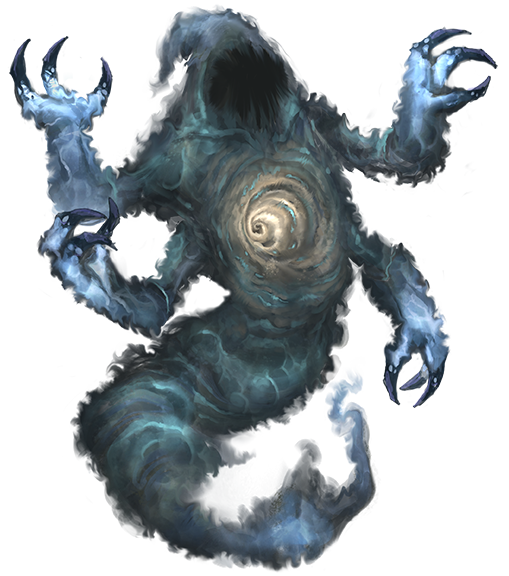
A lipika that is focused on a specific task—whether observing a significant historical event or delivering a message to another being—typically ignores other creatures unless they attempt to delay it from performing its assigned task, at which point it may become violent in its reactions. While it seems they would rather manipulate events subtly, lipikas are capable of great force when faced with those who would thwart their plans.
On rare occasions these aeons appear and create conflicts, claiming that great damage to the multiverse is being done by actions taken by a civilization—actions that are often so minute their consequences might seem arbitrary to the subjects of the aeon’s attention.
Worse still, the appearance of a lipika can herald the coming of even greater displays of aeon power. Sages of occult lore theorize that the information lipikas inscribe into the Akashic Record directly informs the agenda of the concept or entity known as the Monad, and that this information is disseminated to pleromas—more powerful aeons who are direct representatives of the Monad. If this theory is correct, the information scribed by lipikas is of grave consequence to entire civilizations, as pleroma aeons are tasked with acts of creation and destruction that can sometimes impact entire worlds. Those who subscribe to more traditional theories of the multiverse see the connection between lipikas and pleromas in more direct terms. If a lipika cannot accomplish its goals, it calls in a pleroma to enact the strange and inexplicable will of the aeons, often to devastating ends. However, the goals of lipikas are typically so abstract that their intervention often seems random, and few mortals have figured out how to placate them.
Lipikas stand about 13 feet tall but rarely weigh more than 200 pounds—their bodies seem to be hollow. Little distinguishes one lipika from another except the patterns upon their forearms and the colors of their palm-eyes.
Pleroma
The pleroma is the most powerful of all the aeons. As a manifestation of the opposing acts of creation and destruction, a pleroma exists in a state of flux, its very form shifting between creation and oblivion within the ebon folds of its vaporous cloak. One who gazes upon a pleroma could spend days studying the continual changes of its form, which most resemble the shifting of celestial bodies within the universe sped up to a pace at which the swirling of galaxies and the tumble of planets form a strange dance.
Pleromas view the concepts of creation and oblivion not so much as separate processes, but rather as two parts of a cyclical passage that everything in existence must explore. Pleromas guide this progression, ensuring everything remains balanced, such that whatever is created can be destroyed, and that nothing becomes so static that these two processes slow to a halt. For everything that attains a state of semi-permanence, there must be many more things that do not, or rather that cannot ever be reformed into a state of permanence.
While pleromas believe in eternity, they understand that eternity is cyclical and infinity is something that repeats itself. Therefore, eternity and infinity are states that can be changed, or altered, if only slightly. Pleromas maintain such changes are necessary to keep the cosmos from becoming static and unbalanced, a state they refer to as apocalypse, or the end of everything.
Of all the aeons, pleromas possess the strongest connection to the entity or concept they refer to as Monad. All aeons believe themselves to be extensions of this entity, and while they act freely and independently of the entity, they always act within the constricts of its will or needs. This behavior is not so much a state of servitude as a symbiosis in which the actions of the pleromas are universally beneficial to both themselves and the entity they are part of. Pleromas describe Monad as the sentience of the multiverse, from which all things are created through the recycling of everything that ever existed.
Pleromas typically travel alone. Their arrival in a region almost always heralds some sort of dramatic change. They pay little mind to the wants and needs of other creatures, and remain entirely focused upon their primary task. They avoid conflicts of ethics, wars, and similar pursuits, save when manipulating such events would help to restore the balance between creation and oblivion. Should any be so foolish as to attempt to interfere with or sway their work, pleromas immediately retaliate by bringing all of their significant powers and devastating abilities to bear until the intervention is destroyed.



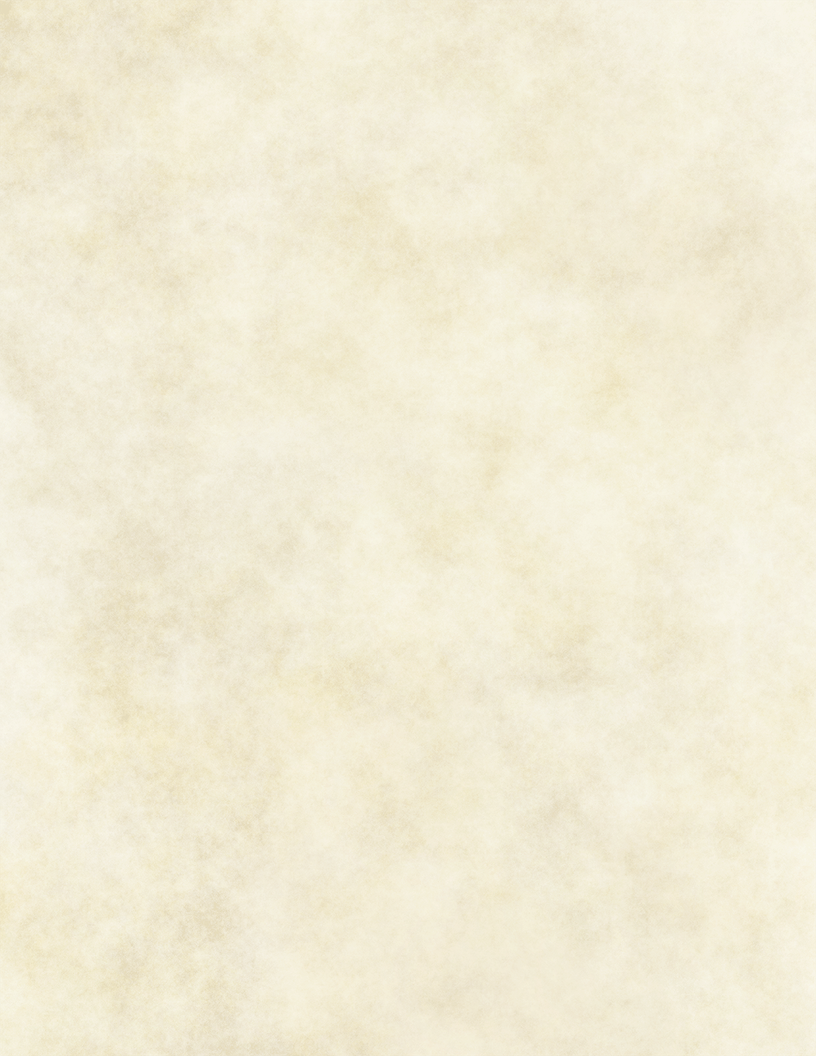
Paracletus
Small aberration (aeon), neutral
- Armor Class 15 (natural armor)
- Hit Points 14 (4d6)
- Speed 0ft., fly 40ft. (hover)
STR DEX CON INT WIS CHA 8 (-1) 16 (+3) 10 (+0) 11 (+0) 13 (+1) 12 (+1)
- Saving Throws Wis +3
- Skills Arcana +2, History +2, Insight +3, Nature +2, Perception +3, Religion +2
- Damage Resistances fire, lightning
- Damage Immunities cold, poison
- Condition Immunities poisoned
- Senses darkvision 60ft., passive Perception 13
- Languages envisaging 100ft.
- Challenge 1 (200 XP)
Magic Resistance. The paracletus has advantage on saving throws against spells and magical effects.
Emotion Aura (3/day). A paracletus exists as the embodiment of a specific emotive duality. Three times per day as a bonus action it can begin projecting an aura in a 30ft radius representing one of its two programmed emotions. The aura lasts for 10 minutes or until the paracletus ends the effect as a bonus action. When a non-aeon creature enters the aura for the first time on a turn or starts its turn there, it must make a DC 11 Wisdom save or be affected by the aura as described below until the start of its next turn. A creature can choose to fail this saving throw.
Any single paracletus can only use one of the below three dualistic options and cannot change to a different one. It can alternate between the two different effects of its aura as a bonus action.
- Courage/Fear: The aura functions as either the bless (courage) or bane (fear) spell for affected creatures.
- Empathy/Apathy: The aura grants creatures advantage (empathy) or disadvantage (apathy) on Deception, Intimidation and Persuasion checks.
- Hope/Despair: The aura grants creatures advantage (hope) or disadvantage (despair) on Wisdom saves.
Innate Spellcasting. The paracletus' innate spellcasting ability is Charisma (spell save DC 11, spell attack bonus +3). It can innately cast the following spells, requiring no material components:
- At Will: sanctuary
- 3/day: calm emotions
Actions
Slam. Melee Weapon Attack: +5 to hit, Reach 5ft., one target. Hit: 5 (1d4 + 3) bludgeoning damage plus 5 (2d4) lightning damage
Variant: Familiar
A Pact of the Chain Warlock can use a paracletus as a form for its familiar. In this case, the paracletus can optionally exclude the warlock from the effects of its emotion aura.
At your discretion, you may wish to restrict the paracletus' innate spellcasting if used as a familiar in this way (for example, limiting sanctuary to 3/day and calm emotions to 1/day), or remove it entirely.
When running a paracletus familiar remember that its aura benefits and hinders all creatures within it!
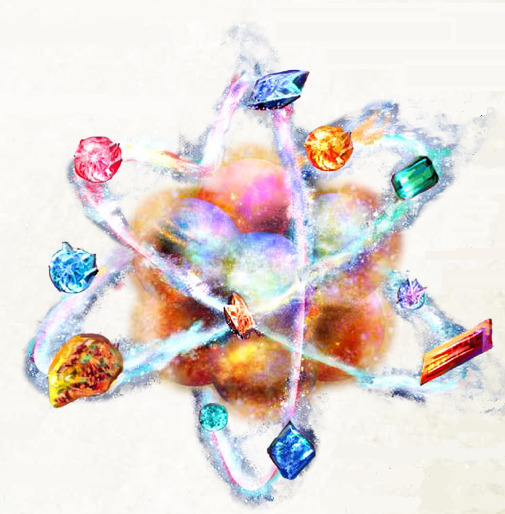
Synesis
Medium aberration (aeon), neutral
- Armor Class 16 (natural armor)
- Hit Points 78 (12d8+24)
- Speed 15ft., fly 30ft. (hover)
STR DEX CON INT WIS CHA 12 (+1) 15 (+2) 14 (+2) 16 (+3) 14 (+2) 15 (+2)
- Skills Arcana +5, History +5, Insight +4, Nature +5, Perception +4, Religion +5
- Damage Resistances fire, lightning
- Damage Immunities cold, poison
- Condition Immunities poisoned
- Senses darkvision 60ft., passive Perception 14
- Languages envisaging 100ft.
- Challenge 4 (1,100 XP)
Magic Resistance. The synesis has advantage on saving throws against spells and magical effects.
Cognitive Aura. A synesis projects an aura of thought in a 30ft radius that bolsters deliberate contemplation at the cost of one’s instinctive judgment or an aura of intuition that does the opposite. It can switch between these effects as a bonus action on its turn. When a creature enters the aura for the first time on a turn or starts its turn there it must make a DC 12 Wisdom save or be affected by the active aura as described below. A creature can choose to fail this saving throw, and the synesis can choose to omit creatures of its choice from the aura's effects. A creatures that succeeds on its saving throw against the synesis's aura is immune to the aura of that synesis for 24 hours.
- Intuition: The aura grants non-aeon creatures advantage on Wisdom checks and Wisdom saving throws, but imposes disadvantage on concentration checks, Intelligence checks and Intelligence saving throws.
- Thought: The aura grants non-aeon creatures advantage on concentration checks, Intelligence checks and Intelligence saving throws, but imposes disadvantage on Wisdom checks and Wisdom saving throws.
Unintuitive Reach. A synesis can stretch its arms and body in unpredictable ways, but only when it would defy the expectations of others. A synesis’s reach increases by 5 feet when it attacks a non-aeon creature with an Intelligence score of 3 or higher.
Innate Spellcasting. The synesis's innate spellcasting ability is Charisma (spell save DC 12, spell attack bonus +4). It can innately cast the following spells, requiring no material components:
- At Will: command (Halt only)
- 3/day: confusion (one target)
Actions
Multiattack. The synesis aeon makes four claw attacks.
Claw. Melee Weapon Attack: +4 to hit, Reach 5ft., one target. Hit: 5 (1d6 + 2) slashing damage plus 3 (1d6) psychic damage
Touch of Idiocy (3/day): One creature the synesis aeon touches must make a DC 12 Intelligence save. On a failed saving throw the creature's mental faculties are impeded.
While impeded, the creature has disadvantage on all Intelligence, Wisdom and Charisma checks, and whenever they attempt to cast a spell they must make a DC 12 Intelligence save. On a failed save, they fail to cast the spell and the spell slot is wasted. An affected creature can repeat the save at the end of each of their turns, ending the effect on a success.
Mental Block (1/day): The synesis aeon drains a creature within 30ft of it of its knowledge and memories, leaving it unable to recall its own capabilities. The creature must make a DC 12 Wisdom save.
On a failed save, the creature's mind is crippled for 1 minute. The creature loses the ability to cast spells or use class features, and does not add its proficiency bonus to any skill checks or attack rolls. An affected creature can repeat the save at the end of each of their turns, ending the effect on a success.


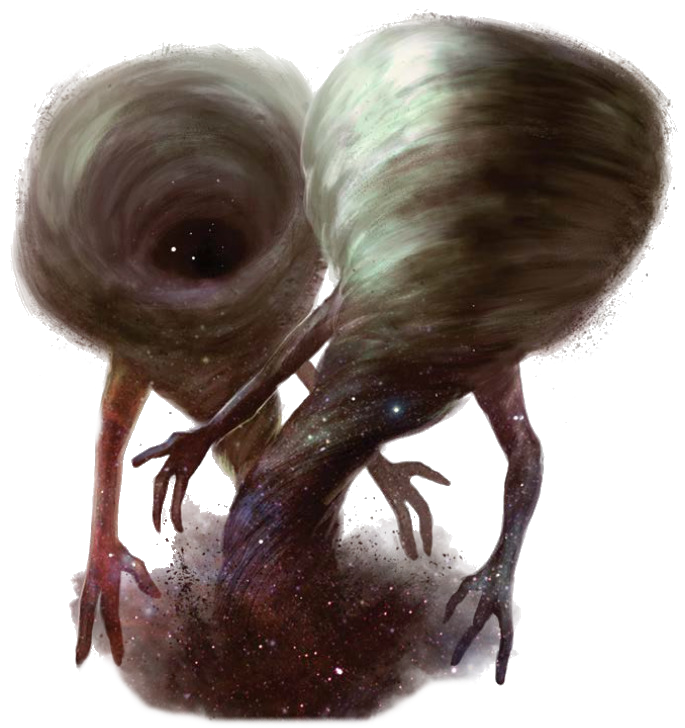
Othaos
Medium aberration (aeon), neutral
- Armor Class 16 (natural armor)
- Hit Points 85 (10d8+40)
- Speed 0ft., fly 30ft. (hover)
STR DEX CON INT WIS CHA 18 (+4) 16 (+3) 19 (+4) 11 (+0) 17 (+3) 14 (+2)
- Skills Arcana +3, History +3, Insight +6, Nature +3, Perception +6, Religion +3
- Damage Resistances fire, lightning
- Damage Immunities cold, poison
- Condition Immunities poisoned
- Senses darkvision 60ft., passive Perception 16
- Languages envisaging 100ft.
- Challenge 5 (1,800 XP)
Magic Resistance. The othaos has advantage on saving throws against spells and magical effects.
Chiaroscuro. An othaos aeon’s physical form changes depending on the level of light present in its space. While in areas of dim light or darkness, an othaos becomes invisible.
It also gains the ability to move through the spaces of other creatures and objects as though they were difficult terrain. It takes 5 (1d10) force damage if it ends its turn in the space of another creature or object, or if it is in the space of another creature or object and no longer in an area of dim light or darkness.
While in this state, the Othaos cannot attack, although it can still cast spells and use its Banish Darkness ability.
Innate Spellcasting. The othaos's innate spellcasting ability is Charisma (spell save DC 13, spell attack bonus +5). It can innately cast the following spells, requiring no material components:
- At Will: dancing lights
- 1/day: darkness, daylight
Actions
Multiattack. The othaos makes four slam attacks.
Slam. Melee Weapon Attack: +7 to hit, Reach 5ft., one target. Hit: 9 (1d8 + 4) bludgeoning damage.
Banish Darkness. An othaos in an area of dim light or darkness can radiate intense light and heat. It projects bright light in a 5ft radius, and dispels any magical darkness from a spell of 3rd level or lower filling that area. All creatures within 5ft of the othaos must make a DC 13 Constitution save, taking 17 (5d6) fire damage on a failed save or half as much on a successful save. It continues to emit light until the start of its next turn, keeping the area around it bright until that time.
Absorb Light. An othaos in an area of bright light or dim light can consume the light and heat around its body. The area within 5ft of the othaos becomes filled with darkness, dispelling any magical light from a spell of 3rd level or lower filling that area. All creatures within 5ft of the othaos must make a DC 13 Constitution save, taking 17 (5d6) cold damage on a failed save or half as much on a successful save. The othaos continues to draw in light until the start of its next turn, keeping the area around it dark until that time.

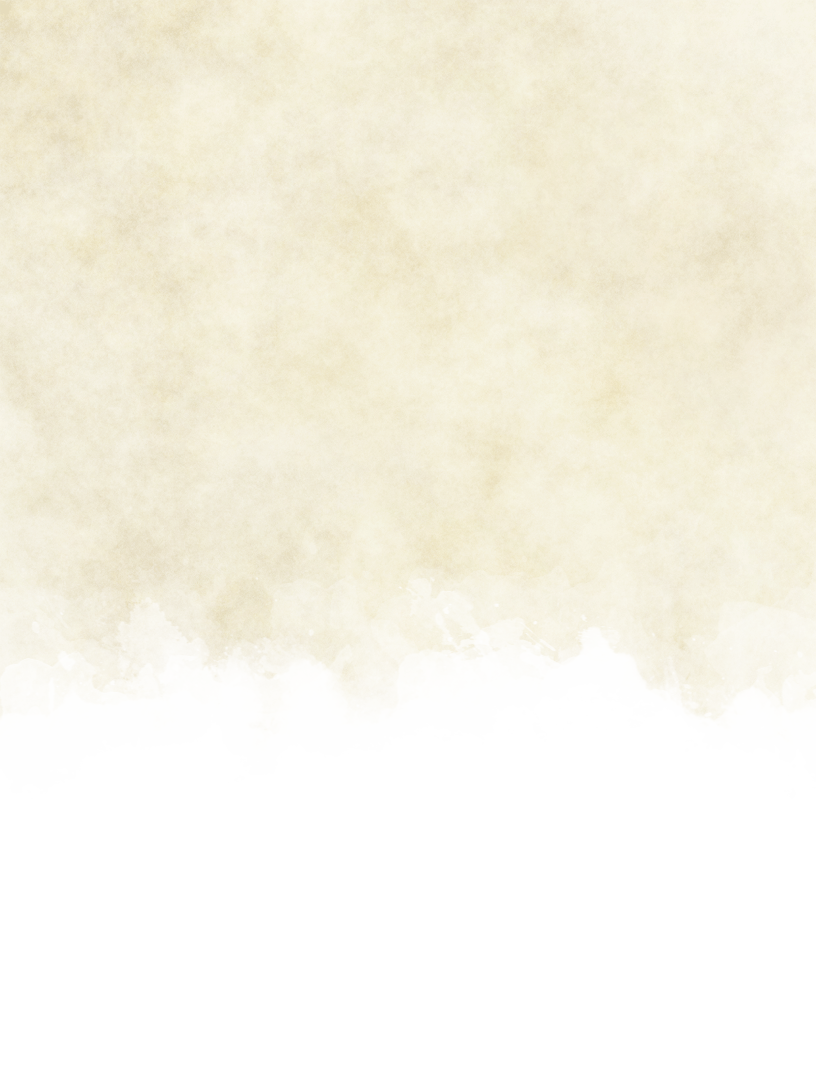
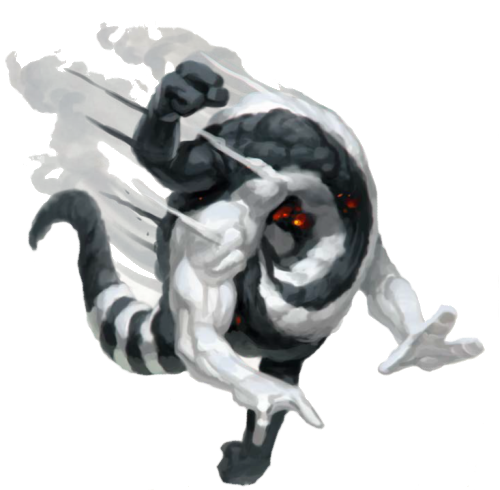
Theletos
Medium aberration (aeon), neutral
- Armor Class 18 (natural armor)
- Hit Points 120 (16d8+48)
- Speed 30ft., fly 30ft. (hover)
STR DEX CON INT WIS CHA 18 (+4) 14 (+2) 17 (+3) 11 (+0) 19 (+4) 12 (+1)
- Saving Throws Wis +7
- Skills Arcana +3, History +3, Insight +7, Intimidation +4, Nature +3, Perception +7, Religion +3
- Damage Resistances fire, lightning
- Damage Immunities cold, poison
- Condition Immunities poisoned
- Senses darkvision 60ft., passive Perception 16
- Languages envisaging 100ft.
- Challenge 7 (2,900 XP)
Magic Resistance. The theletos has advantage on saving throws against spells and magical effects.
Innate Spellcasting. The theletos's innate spellcasting ability is Charisma (spell save DC 13, spell attack bonus +5). It can innately cast the following spells, requiring no material components:
- At Will: augury, cause fear, command, sanctuary
- 3/day: bestow curse, enthrall, dispel magic, remove curse, suggestion
- 1/day: charm monster, geas
Actions
Multiattack. The theletos makes four slam attacks and two fate-drain tentacle attacks.
Slam. Melee Weapon Attack: +7 to hit, Reach 5ft., one target. Hit: 9 (1d8 + 4) bludgeoning damage.
Fate-Drain Tentacle. Melee Weapon Attack: +7 to hit, Reach 5ft., one target. Hit: 7 (1d6 + 4) bludgeoning damage and the target's must make a DC 14 Wisdom save or its charisma score is reduced by 1d4. The target falls unconscious if this attack reduces its charisma score to 0, otherwise the reduction lasts until the target finishes a short or long rest.
While a creature's charisma score is reduced in this way, whenever it makes a saving throw it must roll 1d4 and subtract the number rolled from the result.
Wreath of Fate (recharge 5-6). The theletos releases a 60ft cone of energy from its core. Each creature in the affected area must make a DC 14 Wisdom save. On a failed save, a creature becomes nearly overwhelmed with the knowledge of various fates that destiny has in store for it. This overwhelming flood of knowledge staggers the target, forcing it to choose on each of its turns whether it moves, takes an action, or takes a bonus action; it can do only one of the three.
A creature suffering this effect can choose to let the wreath of fate take hold when it makes an attack roll, ability check or saving throw, imposing disadvantage on its own roll. If it does so, the effect ends. Otherwise the effect can be removed with a casting of remove curse or greater restoration.
Touch of Idiocy (3/day): One creature the theletos touches must make a DC 14 intelligence save. On a failed saving throw the creature's mental faculties are impeded.
While impeded, the creature has disadvantage on all Intelligence, Wisdom and Charisma checks, and whenever they attempt to cast a spell they must make a DC 14 intelligence save. On a failed save, they fail to cast the spell and the spell slot is wasted. An affected creature can repeat the save at the end of each of their turns, ending the effect on a success.


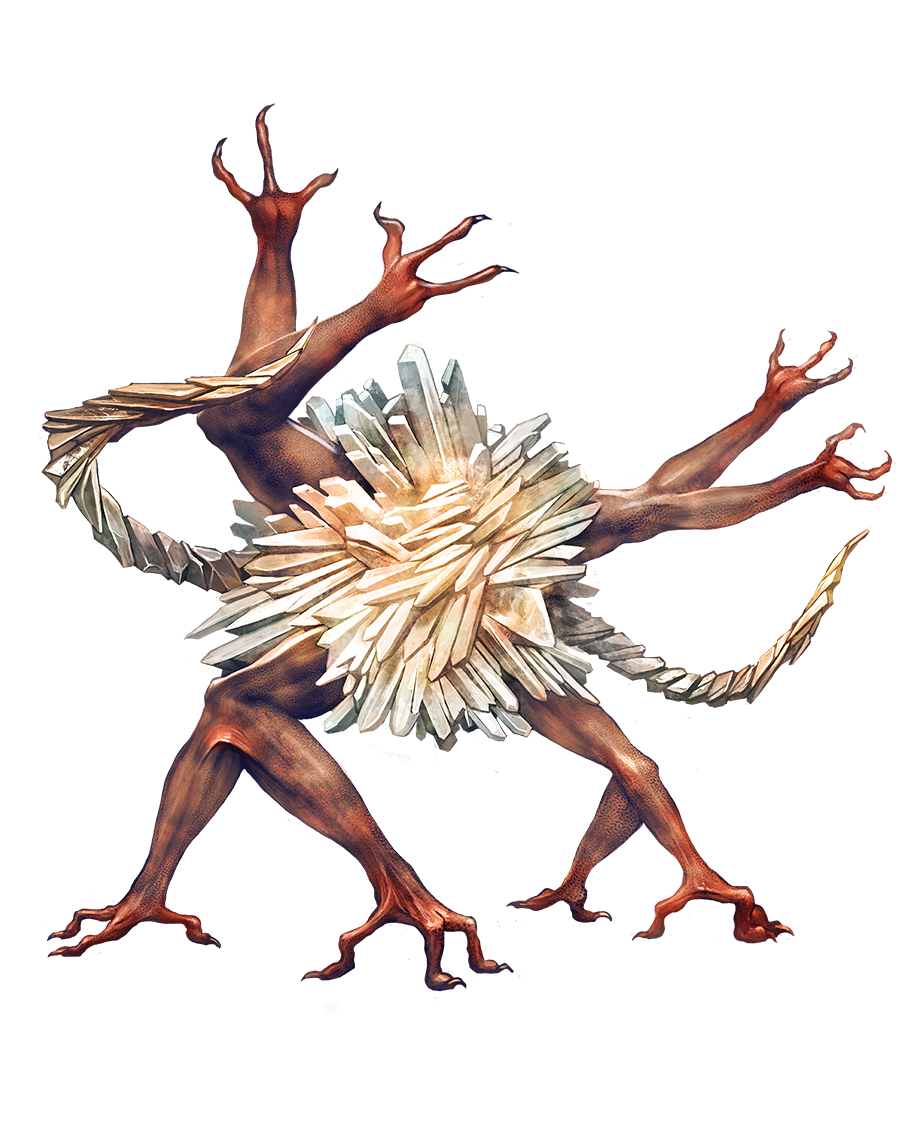
Akhana
Medium aberration (aeon), neutral
- Armor Class 19 (natural armor)
- Hit Points 231 (22d8 + 132)
- Speed 30ft., fly 40ft. (hover)
STR DEX CON INT WIS CHA 18 (+4) 19 (+4) 22 (+6) 16 (+3) 21 (+5) 18 (+4)
- Saving Throws Con +10, Wis +8
- Skills Arcana +7, History +7, Insight +7, Nature +7, Perception +8, Religion +7
- Damage Resistances fire, lightning
- Damage Immunities cold, poison
- Condition Immunities poisoned
- Senses darkvision 60ft., passive Perception 18
- Languages envisaging 100ft.
- Challenge 12 (8,400 XP)
Magic Resistance. The akhana has advantage on saving throws against spells and magical effects.
Innate Spellcasting. The akhana's innate spellcasting ability is Charisma (spell save DC 16, spell attack bonus +8). It can innately cast the following spells, requiring no material components:
- At Will: cure wounds (3rd level), gentle repose, inflict wounds (3rd level), sanctuary
- 3/day: blight, greater restoration
- 1/day: raise dead
Actions
Multiattack. The akhana makes four claw attacks, or it casts a spell and makes two claw attacks.
Claw. Melee Weapon Attack: +8 to hit, Reach 5ft., one target. Hit: 7 (1d6 + 4) slashing damage plus 3 (1d6) necrotic damage and the target is grappled (escape DC 16).
Soul Siphon. If at the start of its turn the akhana has a creature grappled, it can use its bonus action to force that creature to make a DC 18 Constitution save. On a successful save this ability has no effect and the target becomes immune to this akhana's soul siphon for 24 hours. On a failed save the creature's hit point maximum is reduced by 22 (4d10) and it suffers a -1d4 penalty to all attack rolls, ability checks and saving throws for as long as its hit point maximum is reduced in this way. This penalty to rolls is cumulative with multiple uses of this ability.
If this effect reduces a creature's hit point maximum to 0, the creature's soul is torn free from its body and stored within the body of the akhana. The victim’s body remains preserved as if via a gentle repose spell for as long as the soul is held by the akhana. The akhana can keep the soul indefinitely, or can release it as an action.
If the soul is released, the released soul immediately returns to its body if the body is within 300 feet, at which point the body returns to life and any reduction caused to its hit point maximum by this ability ends.
If the body is not within 300 feet (or if it has been destroyed), then the creature dies when its soul is released. A wish spell or divine intervention can force a displaced soul to return to its proper body. If an akhana is slain, any soul it contains is released automatically. An akhana can only hold one soul at a time.


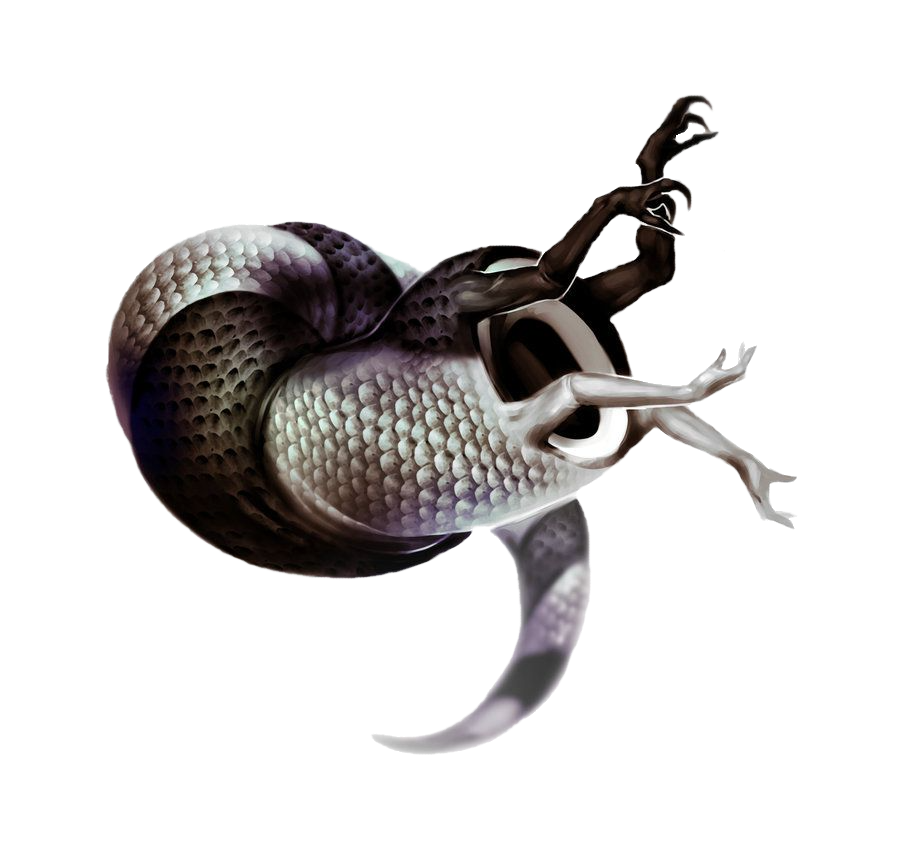
Agnoia
Large aberration (aeon), neutral
- Armor Class 19 (natural armor)
- Hit Points 253 (22d8 + 154)
- Speed 30ft., fly 40ft. (hover)
STR DEX CON INT WIS CHA 26 (+8) 19 (+4) 24 (+7) 25 (+7) 22 (+6) 21 (+5)
- Saving Throws Wis +11
- Skills Arcana +17, History +17, Insight +11, Nature +17, Perception +11, Religion +17
- Damage Resistances fire, lightning
- Damage Immunities cold, poison
- Condition Immunities poisoned
- Senses darkvision 60ft., passive Perception 21
- Languages envisaging 100ft.
- Challenge 14 (11,500 XP)
Magic Resistance. The agnoia has advantage on saving throws against spells and magical effects.
Aura of Ignorance. The agnoia emits an aura of ignorance out to a radius of 30 feet. Whenever a non-aeon creature within this aura attempts an Arcana, History, Nature or Religion check, the check automatically fails.
Forgotten One. A creature under the effects of an agnoia’s feeblemind spell cannot be the target or subject of divination spells. In addition, memory of the target is dulled in all creatures other than aeons; the target cannot be considered an ally of any creature. Most creatures forget about the target once it is out of sight, although friends and family members might retain memories for longer based on the strength of their feelings for the target.
Glance of Understanding. When an agnoia sees a creature, it immediately gains knowledge of their ability scores, class levels (if any), damage resistances, vulnerabilities and immunities, condition immunities, saving throw proficiencies, and any other traits that could prove relevant to the agnoia's interactions with that creature. The agnoia does not learn this information about a creature protected against divination magic.
Constant Detection. The agnoia is constantly under the effects of the detect magic and detect thoughts spells. Charisma is its spellcasting ability for these spells.
Compression. The agnoia can move through any space large enough for a tiny creature without squeezing.
Innate Spellcasting. The agnoia's innate spellcasting ability is Charisma (spell save DC 19, spell attack bonus +11). It can innately cast the following spells, requiring no material components:
- At Will: modify memory
- 3/day: feeblemind
Actions
Multiattack. The agnoia makes three claw attacks and uses its touch of idiocy.
Claw. Melee Weapon Attack: +13 to hit, Reach 10ft., one target. Hit: 15 (2d6 + 8) slashing damage and the target's Intelligence score is reduced by 1d4. The target falls unconscious if its Intelligence score is reduced to 0 by this effect. Otherwise, the reduction lasts until the target finishes a short or long rest.
Touch of Idiocy (3/day): One creature the agnoia touches must make a DC 19 Intelligence save. On a failed saving throw the creature's mental faculties are impeded.
While impeded, the creature has disadvantage on all Intelligence, Wisdom and Charisma checks, and whenever they attempt to cast a spell they must make a DC 19 Intelligence save. On a failed save, they fail to cast the spell and the spell slot is wasted. An affected creature can repeat the save at the end of each of their turns, ending the effect on a success.

Bythos
Large aberration (aeon), neutral
- Armor Class 21 (natural armor)
- Hit Points 273 (26d10 + 130)
- Speed 0ft., fly 40ft. (hover)
STR DEX CON INT WIS CHA 22 (+6) 19 (+4) 21 (+5) 24 (+7) 28 (+9) 21 (+5)
- Saving Throws Con +10, Wis +14
- Skills Arcana +12, History +12, Insight +14, Nature +12, Perception +14, Religion +12
- Damage Resistances fire, lightning; bludgeoning, piercing and slashing damage from nonmagical weapons
- Damage Immunities cold, poison
- Condition Immunities poisoned
- Senses blindsight 60ft; darkvision 90ft., passive Perception 24
- Languages envisaging 100ft.
- Challenge 16 (15,000 XP)
Magic Resistance. The bythos has advantage on saving throws against spells and magical effects.
Confusion Gaze. When a creature starts its turn within 30ft of the bythos and can see it, the bythos can force that creature to make a DC 18 Wisdom save if it isn't incapacitated and can see the creature. If the creature fails the save, it becomes confused (as the spell). A creature that becomes confused in this way can repeat the save at the end of each of their turns, ending the effect on a success.
Moment of Prescience (1/day). Once per day, the bythos can choose to gain a +15 bonus to one attack roll, ability check or saving throw. It must choose to utilise this bonus before it rolls.
Innate Spellcasting. The bythos's innate spellcasting ability is Charisma (spell save DC 18, spell attack bonus +10). It can innately cast the following spells, requiring no material components:
- At Will: augury, teleport, slow
- 3/day: haste, plane shift
Actions
Multiattack. The bythos makes four aging claw attacks. It can replace one of these attacks with a use of its temporal shift ability.
Aging Claw. Melee Weapon Attack: +12 to hit, Reach 5ft., one target. Hit: 13 (2d6 + 6) slashing damage plus 7 (2d6) cold damage, and the target must make a DC 18 Constitution save or be aged by 20% of its natural lifespan.
If this causes a creature to age beyond its natural lifespan (which typically occurs after 3-4 failed saving throws), it dies. For each time the creature's age increases, it suffers a cumulative -1d4 penalty on all Strength, Dexterity and Constitution based rolls. This process is reversible with greater restoration or wish.
Temporal Shift (recharge 5-6). One creature the bythos touches must make a DC 18 Charisma save or be shunted forward in time. The creature disappears from the present and reappears in the same location 1d4 rounds later as if no time had passed. If an object occupies that space, the creature appears in the closest available space to its original location.
Temporal Stasis (1/day). One creature the bythos touches must make a DC 18 Constitution save. For the creature, time ceases to flow, and its condition becomes fixed. The creature does not grow older. Its body functions virtually cease, and no force or effect can harm it. This state persists until the magic is removed using dispel magic (treating the effect as an 8th level spell), greater restoration or wish.
Dimensional Anchor (3/day). One creature the bythos touches must make a DC 18 Charisma save. On a failed save, the creature becomes incapable of teleportation or interplanar travel. The creature cannot utilise spells such as plane shift, teleport or dimension door, and cannot be subject to spells like banishment. An affected creature can repeat the save at the end of each of its turns, ending the effect on a success.
Dimensional Lock (1/day). The bythos aeon designates a 20ft radius sphere centered on a point it can see within 120ft of it. Teleportation or interplanar travel into, out of, or within that space becomes impossible. Spells such as banishment, blink, gate, plane shift, teleport, dimension door or misty step do not function if their destination is within the area, or if the creature being targeted or teleported is within the area.

Lipika
Large aberration (aeon), neutral
- Armor Class 22 (natural armor)
- Hit Points 275 (22d10 + 154)
- Speed 30ft., fly 60ft. (hover)
STR DEX CON INT WIS CHA 22 (+6) 23 (+6) 24 (+7) 22 (+6) 25 (+7) 23 (+6)
- Saving Throws Con +13, Wis +13, Cha +12
- Skills Arcana +12, Deception +12, History +12, Insight +13, Intimidation +12, Nature +12, Perception +13, Persuasion +12, Religion +12
- Damage Resistances fire, lightning; bludgeoning, piercing and slashing damage from nonmagical weapons
- Damage Immunities cold, poison
- Condition Immunities poisoned
- Senses darkvision 60ft., passive Perception 22
- Languages envisaging 100ft.
- Challenge 18 (20,000 XP)
Magic Resistance. The lipika has advantage on saving throws against spells and magical effects.
Adaptive Defense. After the lipika takes damage other than bludgeoning, piercing or slashing damage, it becomes immune to that damage type until the end of its next turn.
Karmic Reflection. If a lipika fails a saving throw against a spell that targets only it, the spell is also reflected back at the original caster, using the caster's spell save DC.
Reactive Parrying. When a creature hits the lipika with an attack, that creature has disadvantage on attack rolls against the lipika for the rest of the current turn.
Innate Spellcasting. The bythos's innate spellcasting ability is Charisma (spell save DC 18, spell attack bonus +10). It can innately cast the following spells, requiring no material components:
- At Will: plane shift, telekinesis
- 3/day: geas
- 1/day: reincarnate
Actions
Multiattack. The lipika makes four karmic slam attacks, or four force blast attacks.
Karmic Slam. Melee Weapon Attack: +12 to hit, Reach 5ft., one target. Hit: 16 (3d6 + 6) bludgeoning damage and the target must make a DC 21 Wisdom save. If it fails, it is linked to the lipika via a karmic link for 1 minute.
For the duration, whenever the linked creature deals damage to the lipika, the lipika takes only half the damage and the linked creature takes the same amount of damage. An affected creature can repeat the saving throw at the end of each of their turns, ending the effect on a success.
Force Blast. Ranged Weapon Attack: +12 to hit, Range 300ft., one target. Hit: 24 (7d6) force damage.
Reactions
Karmic Strike. When the lipika is struck by an attack, it can make an attack as a reaction against the creature that attacked it. It must make a karmic slam attack if the triggering attack was a melee attack from within 5ft, or a force blast attack otherwise.


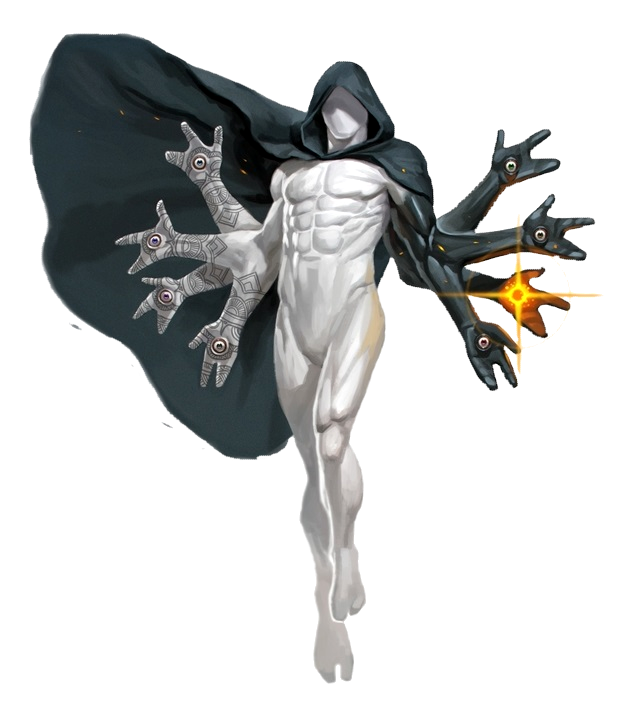
Pleroma
Large aberration (aeon), neutral
- Armor Class 24 (natural armor)
- Hit Points 351 (26d10 + 208)
- Speed 30ft., fly 60ft. (hover)
STR DEX CON INT WIS CHA 24 (+7) 27 (+8) 26 (+8) 26 (+8) 30 (+10) 25 (+7)
- Saving Throws Con +15, Int +15, Wis +17, Cha +14
- Skills Arcana +15, Deception +14, History +15, Insight +17, Intimidation +12, Nature +15, Perception +25, Persuasion +14, Religion +15
- Damage Resistances fire, lightning; bludgeoning, piercing and slashing damage from nonmagical weapons
- Damage Immunities cold, poison
- Condition Immunities poisoned
- Senses truesight; blindsight 120ft., darkvision 120ft., passive Perception 35
- Languages envisaging 100ft.
- Challenge 24 (62,000 XP)
Magic Resistance. The pleroma has advantage on saving throws against spells and magical effects.
Awareness. The pleroma cannot be surprised, and unseen attackers do not gain advantage on attacks against it as a result of being unseen.
Legendary Resistance (3/day). If the pleroma fails a saving throw, it can choose to succeed instead.
Innate Spellcasting. The pleroma's innate spellcasting ability is Charisma (spell save DC 22, spell attack bonus +14). It can innately cast the following spells, requiring no material components:
- At Will: create food and water, fabricate, mending, plant growth, stone shape
- 3/day each: abi-dalzim's horrid wilting, creation, daylight, darkness, disintegrate, freedom of movement, greater restoration
- 1/day: mage's disjunction*, wish
Spellcasting. The pleroma is a 20th level spellcaster. Its spellcasting ability is Wisdom (spell save DC 25, spell attack bonus +17). It has the following spells prepared:
- Cantrips (at will): guidance, light, resistance, true strike
- 1st level (4/day): detect magic, detect evil and good, identify
- 2nd level (3/day): detect thoughts, enthrall, magic weapon, suggestion, zone of truth
- 3rd level (3/day): clairvoyance, chaos hammer*, holy smite*, magic circle, order's wrath*, unholy blight*
- 4th level (3/day): banishment, sickening radiance
- 5th level (3/day): contact other plane, dispel evil and good, geas, legend lore, scrying
- 6th level (2/day): forbiddance, veil*
- 7th level (2/day): destruction*, divine word, teleport
- 8th level (1/day): holy aura
- 9th level (1/day): astral projection, gate, implosion*
New Spells
Some of the listed spells on the pleroma's spell list are new spells detailed in the new spells section at the bottom of this document.


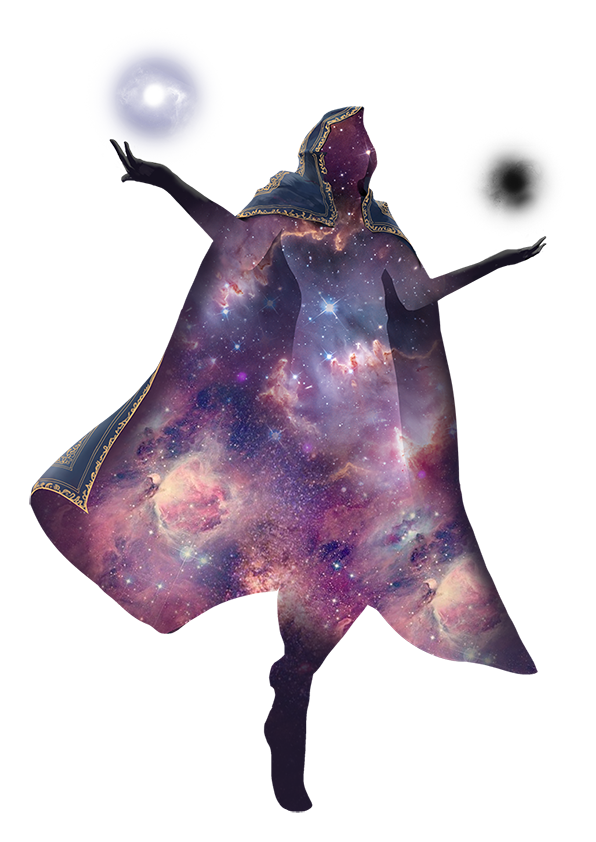
Actions
Energy Touch. Melee Weapon Attack: +15 to hit, Reach 10ft., one target. Hit: 90 (20d8) radiant or necrotic damage (the pleroma's choice).
Hurl Sphere (requires active Sphere of Oblivion within 10ft). Ranged Weapon Attack: +15 to hit, Range 20/60ft., one target. Hit: The target is affected as if they had touched the hurled sphere of oblivion. The sphere of oblivion then immediately implodes and vanishes harmlessly.
Sphere of Creation (3/day). The pleroma can manifest a 2-foot-diameter sphere of white energy that hovers above its left hand. The pleroma can control this sphere, causing it to slowly hover 10ft in any direction as a bonus action on each of its turns. The sphere must remain within 300 feet of the pleroma or it immediately dissipates.
Wherever the sphere travels, it leaves behind a 5-foot-wide path of new matter, creating either new terrain (such as swamp, tundra, desert, or forest) or a 10-foot-square wall composed of a single natural substance (such as clay, wood, or stone).
Any existing matter, either living or nonliving that comes in contact with the sphere must make a DC 23 Constitution save or be absorbed and incorporated into the new substance (only a wish spell or divine intervention can rescue creatures so trapped). Creatures that succeed on their saving throw are pushed to the nearest unoccupied space adjacent to the newly created substance.
The sphere is highly unstable and only lasts for 1 minute before it explodes with a blinding flash. The pleroma can also use a bonus action to detonate the sphere early. All creatures within 30 feet of the sphere when it explodes must make a DC 23 Constitution save or be permanently blinded.
Sphere of Oblivion (3/day). The pleroma can manifest a 2-foot-diameter sphere of complete and utter darkness that hovers above its right hand. The pleroma can control this sphere, causing it to slowly hover 10ft in any direction as a bonus action on each of its turns. The sphere must remain within 300 feet of the pleroma or it immediately dissipates.
Wherever the sphere travels, it leaves behind a 5-foot-wide path of new matter, creating either new terrain (such as swamp, tundra, desert, or forest) or a 10-foot-square wall composed of a single natural substance (such as clay, wood, or stone).
The sphere is an empty void similar to a sphere of annihilation. Any large or smaller object that touches the sphere is sucked into the sphere and destroyed; a larger object has a 10ft section around the sphere destroyed in this way. A creature that touches the sphere must make a DC 23 Constitution save, taking 110 (20d10) force damage on a failed save or half as much on a successful save. If this damage reduces the creature to 0 hit points, it is utterly destroyed. Only true resurrection or wish can restore a creature destroyed in this way to life.
The sphere is highly unstable and only lasts for 1 minute before it implodes harmlessly.
Legendary Actions
The pleroma can take 3 legendary actions, choosing from the options below. Only one legendary action can be used at a time, and only at the end of another creature's turn. Spent legendary Actions are regained at the start of each turn.
Move Sphere. The pleroma moves an active Sphere of Creation or Sphere of Oblivion 10ft in any direction. It can move a given sphere only once in this way each round.
Cast a Spell (costs 2 actions). The pleroma casts a spell with a casting time of 1 action or 1 bonus action.
Create Sphere (costs 2 actions). The pleroma creates a Sphere of Creation or Sphere of Oblivion.
Move. The pleroma moves up to its speed.


New Spells
Chaos Hammer
4th level evocation (cleric, paladin)
- Casting Time: 1 action
- Range: 120ft.
- Components: V, S
- Duration: Instantaneous
You unleash chaotic power to smite your enemies. The power takes the form of a multicolored explosion of leaping, ricocheting energy. Each non-chaotic aligned creature in a 20ft radius sphere centred on a point within range must make a Wisdom saving throw, taking 6d8 force damage on a failed save or half as much on a successful save.
On a failed save a creature is also slowed (as the spell) for 1 minute due to being disoriented by the chaotic energy. A creature slowed by this spell can repeat the saving throw at the end of each of its turns, ending the effect on a success.
Creatures that are neither lawful or chaotic take half damage and are not slowed even if they fail the save.
Lawfully aligned aberrations, celestials, elementals, fey, fiends and undead have disadvantage on their initial saving throw against this spell.
At Higher Levels. When you cast this spell at higher levels, the force damage increases by 1d8 for each spell level over 4th.
Holy Smite
4th level evocation (cleric, paladin)
- Casting Time: 1 action
- Range: 120ft.
- Components: V, S
- Duration: Instantaneous
You call down a blast of holy light to smite your enemies. Each non-good creature of your choice in a 20ft radius must make a Wisdom save, taking 6d8 radiant damage on a failed save or half as much on a successful save.
On a failed save a creature is also blinded. A blinded creature can repeat the save at the end of each of its turns, ending the effect on a success.
Creatures that are neither good or evil take half damage and are not blinded even if they fail the save.
Evil-aligned aberrations, celestials, elementals, fey, fiends and undead have disadvantage on their initial saving throw against this spell.
At Higher Levels. When you cast this spell at higher levels, the radiant damage increases by 1d8 for each spell level over 4th.
Order's Wrath
4th level evocation (cleric, paladin)
- Casting Time: 1 action
- Range: 120ft.
- Components: V, S
- Duration: Instantaneous
You call upon the power of law to smite the unruly in an area. Each non-lawful creature of your choice in a 20ft radius must make a Wisdom save, taking 6d8 force damage on a failed save or half as much on a successful save.
On a failed save a creature is also bound by the lawful energies and neither takes any actions nor moves until the end of its next turn.
Creatures that are neither lawful or chaotic take half damage and are not bound even if they fail the save.
Chaotic-aligned aberrations, celestials, elementals, fey, fiends and undead have disadvantage on their initial saving throw against this spell.
At Higher Levels. When you cast this spell at higher levels, the force damage increases by 1d8 for each spell level over 4th.
Unholy Blight
4th level evocation (cleric, paladin)
- Casting Time: 1 action
- Range: 120ft.
- Components: V, S
- Duration: Instantaneous
You draw on dark and unholy energies to afflict your enemies with corruptive power. Each non-evil creature of your choice in a 20ft radius must make a Wisdom save, taking 6d8 necrotic damage on a failed save or half as much on a successful save.
On a failed save a creature is also poisoned. A poisoned creature can repeat the save at the end of each of its turns, ending the effect on a success.
Creatures that are neither good or evil take half damage and are not poisoned even if they fail the save.
Good-aligned aberrations, celestials, elementals, fey, fiends and undead have disadvantage on their initial saving throw against this spell.
At Higher Levels. When you cast this spell at higher levels, the necrotic damage increases by 1d8 for each spell level over 4th.
Alignment Mechanics
The above spells utilise a mechanic not widely employed in 5e: mechanical implications of alignment. If you prefer not to employ such mechanics in your game, you can alter the spells to reflect that. Reduce the damage of each spell by 1d8 to reflect the increased versatility, and remove all references to alignment from the spells. At your option, you may also remove the disadvantage on saving throws that certain creature types have - applying to all such creatures is significantly more powerful than applying to a subset of them limited based on alignment.
Veil
6th level illusion (bard, sorcerer, warlock, wizard)
- Casting Time: 1 action
- Range: 120ft.
- Components: V, S
- Duration: Concentration, up to 8 hours
This spell allows you to change the appearance of any number of creatures that you can see within range. You give each target you choose a new, illusory appearance. An unwilling target can make a Charisma saving throw, and if it succeeds, it is unaffected by this spell. You can make the subjects appear to be anything you wish, including completely altering their body type or size. The subjects look, feel, and smell just like the creatures the spell makes them resemble, although a creature's mobility is still limited by their true size, so a large creature will not fit into a smaller space if disguised as a smaller creature. Affected creatures resume their normal appearances if slain.
Other creatures rationalise any illogical outcomes from interacting with the illusion. For example, a creature forced to move around a large creature disguised as a smaller one will rationalise that they simply chose to take the wider path.
A creature can use its action to inspect a target and make an Intelligence (Investigation) check against your spell save DC. If it succeeds, it becomes aware that the target is disguised.
Destruction
7th level necromancy (cleric)
- Casting Time: 1 action
- Range: 30ft.
- Components: V, S, M (a holy symbol worth at least 500g)
- Duration: Instantaneous
You choose one creature of your choice within range to make a Constitution saving throw. On failed save, the creature takes 80 damage, which is radiant if your alignment is good, and necrotic if your alignment is evil. A neutral character can choose the damage type. On a successful save, the creature takes 10d6 radiant or necrotic damage instead.
If the spell reduces the target to 0 hit points, their body is utterly consumed in holy (or unholy) fire, leaving their equipment intact. The only way to restore such a creature to life is using a wish spell or comparable magic.
At Higher Levels. When you cast this spell at higher levels, the damage on a failed save increases by 20 for each spell level over 7th.
Mage's Disjunction
9th level abjuration (wizard)
- Casting Time: 1 action
- Range: 30ft.
- Components: V
- Duration: Instantaneous
All magical effects and magic items within a 40ft radius sphere centered on a pointed within range, except for those that you carry or touch, are disjoined. That is, spells and magical effects are unraveled and destroyed completely (ending the effect as a dispel magic spell does), and each permanent magic item must make a successful Charisma save or be turned into a normal item for 10 minutes. An item in a creature’s possession uses its own Charisma save or its wielder's, whichever is higher. If an item’s saving throw results in a natural 1 on the die, the item is destroyed instead of being suppressed.
An antimagic field has a 20% chance of being destroyed by this effect. If the antimagic field is not destroyed, no items with it are affected by this casting of mage's disjunction.
You can instead use this spell to target a single item. In this case, the item must make a Charisma save or be destroyed. As before, an item in a creature’s possession uses its own Charisma save or its wielder's, whichever is higher.
There is a 20% chance of being able to destroy an artifact with this effect, and if successful, you must succeed on a DC 25 Charisma save or lose all spellcasting ability permanently. These abilities cannot be recovered by mortal magic, not even a wish spell. Destroying artifacts is a dangerous business, and it is 95% likely to attract the attention of some powerful being who has an interest in or connection with the device.
An item's saving throw modifier is dependent on its rarity, as outlined in the table below:
| Item Rarity | Charisma saving throw modifier |
|---|---|
| Common | +0 |
| Uncommon | +2 |
| Rare | +4 |
| Very Rare | +6 |
| Legendary | +8 |
| Artifact | Varies (DM's discretion, minimum +10) |
Implosion
9th level evocation (cleric)
- Casting Time: 1 action
- Range: 30ft.
- Components: V, S
- Duration: Concentration, up to 1 minute
This spell causes a destructive resonance in a corporeal creature’s body. When you cast the spell, and as an action on each of your turns for the spell’s duration, you can cause one creature to collapse in on itself. The creature must make a Constitution save. On a failed save, the creature takes 25d12 force damage. If this damage reduces them to 0 hit points, they implode into a compressed mass of matter with no resemblance to their previous form.
You can target a particular creature only once with each casting of the spell. Implosion has no effect on creatures in gaseous form or on incorporeal creatures.
